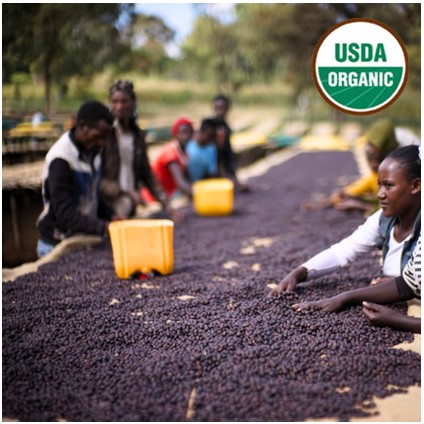A celebrated favorite among aficionados for decades now, Ethiopian Yirgacheffe requires almost no introduction. Known for its fruity, floral flavors and sweet finish, “Yirg” (as it’s commonly referred to), is a staple in the specialty roast and brewing community. Grown at a “low” elevation of ~2,000 feet, Yirgacheffe produces the expected low-acid, mild brewed cup. And since I’ve already taken the left turn at Albuquerque (“How altitude affects coffee flavor”) I’ll take a few moments and write up a quick reference for context:
- Up to and at 2000 FASL: Very low altitude – grown coffee. Low acidity, “sharper” flavors with sometimes nutty finishes. Generally, this altitude produces higher caffeine coffees.
- 2500 FASL: Low altitude. Less “sharper” flavors and a slight increase in acidity putting these coffees in the low-to-mid acidity range. Fruitier and spicier notes that tend to shine through in medium roasts. Hawaiian “Kona” is grown at this altitude.
- 3000 FASL: Medium altitude. Smooth, balanced coffees generally thought of as “balanced”, medium acidity varietals. Sweeter notes, caramel and dark chocolate characteristics are common at this altitude.
- 4000 FASL: High altitude. Regions such as Costa Rica, Nicaragua and Indonesia are known for their high-acidity (“Bright”) coffees but don’t let this shy you away from the full-bodied, buttery texture and heavy chocolate overtones. These varietals typically shine in MBE (milk-based espresso) cups and have a wide breadth of flavor notes. Cupping notes rife with “hazelnut”, “vanilla” and “cocoa” are very commonplace among high altitude coffees.

Situated at the low end of this spectrum, Yirgacheffe delivers a slightly higher than expected “medium” acidity but still is considered quite calm from a “brightness” perspective. Our supplier’s cupping notes are “Cinnamon, Clove, Hibiscus, Lemon, Pear, and Winey” with medium body.
We have already started delivering Yirgacheffe as a single – origin (non-blended) in two roasts: Medium and Medium Dark. The medium dark was given a slightly higher development time in the roaster using a low charge and ramp up protocol, giving these batches slightly more time to develop the floral tones Yirgacheffe is so widely celebrated for. The medium roast, conversely, is roasted with a shorter development time since the lighter roast will allow for the simpler, less complex citrus notes to dominate.
As a general rule of thumb, the darker roast will be ideal for moka pots (stove-top Italian pots) and espresso machines while the lighter, medium roast will be more suitable in pour-over, drip machines and French press. Again, these are generalizations and should only be used a starting point in your brewing adventures. As always, we encourage everyone to experiment with dosages, brewing methods and mixing into those our different roasts.
In closing, we’d love to hear what you think! Leave us a substantive comment below or email us to tell us your favorite brew method or any feedback you’d like to share on this, or any other of our offerings, and be eligible to win a free pound of coffee!!
More notes below from our Volcafe Fair Trade provider on this amazing coffee:
Ethiopia Yirgacheffe Organic Natural Coffee
The Chelbesa kebele (village) is a renowned producing area in Yirgacheffe in the Gedeo Zone of Ethiopia’s Southern Nations, Nationalities, and Peoples’ Region (SNNPR). Here, shade-grown coffee thrives under a dense, layered, semi-forest canopy. The Chelbesa wet mill was established in 2019 with the goal of sourcing fresh coffee cherries from hundreds of nearby smallholders. Over 760 producers contributed to this Grade 2 natural processed coffee.
Ethiopian Yirgacheffe Coffee
Considered by many to be the birthplace of coffee, Yirgacheffe needs little introduction. Ancient landrace varieties dominate the smallholder coffee gardens that are often organic by default, tended by farmers who intercrop food crops to maximize the potential of this region’s fertile soil.
Most Yirgacheffe farmers are smallholders farming fewer than three hectares. Coffee is generally sold as cherry to centralized washing stations. This practice helps control quality and allows wet mills to bring out the distinctive Yirgacheffe terroir.
Natural Processed Ethiopian Coffee
In the natural process, only the ripest coffee cherries are harvested. The entire procedure requires thorough planning because drying naturals is a slow process that can take up to four weeks. Coffee cherries are dried whole, without removing any of the fruit. During this stage, the coffee is turned regularly to increase airflow, support even drying, and prevent spoilage. After the cherries have been dried, the seeds (or coffee beans) are removed from the fruit and prepared for export.
Ethiopian Coffee Varietals
Thousands of different landrace varietals still grow wild in the mountainous forests of Ethiopia. The Jimma Agricultural Research Center (JARC) is working to research and identify unique varietals and strains like Wolisho and Dega, two varieties named after indigenous trees in the region.
Ethiopia Coffee Quality Grading
Coffee grading in Ethiopia is based on the combined result of physical qualities and cup qualities, including altitude, imperfections, and flavor. Grades range from 1 (high) to 9 (low), with grades 1 and 2 considered specialty. High-quality natural coffees from Yirgacheffe like this one often express hallmark characteristics of bright citrus acidity and excellent sweetness.
Ethiopia Green Coffee
Ethiopia, the homeland of Arabica coffee, might only produce 3-4% of the world’s coffee supply, but the variety of character that comes from this origin is astounding. Ethiopia green coffee is celebrated for its bright fruit and floral flavors, expressed with exceptional acidity and sweetness. Out of the many coffee-growing districts in the country, a few stand out from the crowd with their highly distinctive cup profiles, like Yirgacheffe, Sidama, and Guji.
